
Tuesday Jun 30, 2020
How to Optimize Your Marketing Automation Workflows for Higher Conversions

Introduction: Why You Need Marketing Automation Workflows
You're missing out on significant revenue opportunities if you're not leveraging marketing automation workflows to nurture leads and drive them down your sales funnel. With the integration of marketing automation in popular email marketing platforms like MailChimp, there's no excuse for letting your contacts sit idle.
Neethere'sting Automation Help? Click Here!

What Are Marketing Automation Workflows?
Understanding the Basics
Marketing automation workflows are the backbone of a revenue-generating strategy. They allow you to automate marketing tasks in a structured and systematic manner. For instance, when someone visits your website to fill out a form or seek more information, a marketing automation workflow ensures they receive timely and relevant emails.
The Role of Email Sequences
Upon capturing an email address through an opt-in form, the first step is usually to send a welcome email sequence. This sequence introduces your business, explaining who you are, what you do, and why the prospect should consider working with you.
Setting Up Your Marketing Automation Workflow
The Importance of Automated Welcome Emails
The key to a triumphant welcome email sequence is to introduce your business and set the stage for future interactions. With a well-designed marketing automation workflow, you don't have to send these emails manually; software like Adon'tRM can handle it.
Behind-the-Scenes Automation
The beauty of marketing automation is that it operates behind the scenes. All your marketing activities, including emails, text messages, and other tasks, are automatically triggered without you lifting a finger. This automation lets you focus on warming up your leads for future business.
Segmenting Leads in Your CRM
Why Segmentation Matters
Effective marketing automation workflows rely on segmentation. Depending on your prospects' actions—whether they fill out a survey, download a report, or engage with your emails—you can categorize them into different segments. This ensures they receive content most relevant to their interests and stage in the buyer's journey.
Sales Automation and Workflows
When running buyers ' campaigns, your marketing automation workflows must be tuned. For example, if you're promoting a Memorial Day sale, your entire market should be on that. You don't want to confuse your audience by sending unrelated don'ts during the promotion.
Nurturing Leads Through Automation
The Art of Lead Nurturing
Lead nurturing is another critical aspect of a robust marketing automation workflow. Through emails, you can introduce your team, showcase case studies, and explain why the prospect should do business with you.
Upsells and Cross-Sells in Marketing Automation
Maximizing Revenue Opportunities
Your marketing automation workflow should also include strategies for upsells and cross-sells. Automated emails can encourage customers to complete the purchase if they buy an E-book but skip the upsell for a video course.
Re-Engaging Your Email List
The Last Chance Offer
If a contact hasn't engaged with your content for 60 days or more, your meeting automation workflow should automatically send them a re-engagement email. This could be a special offer or a free report to recapture their interest.
Onboarding New Customers
Creating a Seamless Experience
The customer journey doesn't end with a purchase; it's just the beginning. Mardoesn'tautomation workflows can help you onboard new customers effectively. Automated emails can guide them through the following steps: scheduling a call, logging into a course, or watching video.
Conclusion: The Future is Automated
Marketing automation workflows are not just a 'nice-to-have'; they are essential for any business looking to scale. from sending welcome emails to segmenting your audience and nurturing leads, automation can handle it all, so if you haven't yet implemented a marketing automation workflow, haven't time to start.
The Power of Marketing Automation Workflows
Marketing automation workflows are the unsung heroes of modern digital marketing. They allow you to automate complex tasks and nurture your leads in a personalized way. In this guide, we'll explore seven essential types of marketing automating workflows that can transform your email marketing strategy.
1. The Welcome Email Sequence: Your First Impression
What is a Welcome Email Sequence?
The welcome email sequence is your first interaction with new email subscribers. It's a one-time workflow designed to introduce your brand. It's set the stage for future communications.
Why is it Important?
A well-crafted welcome email sequence ensures your new contacts don't forget about you shortly after signing up. It provides a brief orientation about your brand and can deepen the relationship immediately.
How Many Emails Should It Include?
Generally, a welcome email sequence doesn't need to be extensive. Three to four emails are insufficient to make a lasting impression.
2. Segmentation and Engagement: The Backbone of Marketing Automation Workflows
What is Segmentation?
Segmentation is one of the most crucial types of marketing automation workflows. It involves dividing your email list into smaller groups based on specific criteria like interests, behavior, or demographics.
Why is Segmentation Important?
You can send highly targeted content and promotions by segmenting your audience and increasing engagement and conversion rates.
Criteria for Segmentation
You can segment people based on various factors, such as:
- The lead magnet they've downloaded
- The landing page they visited
- The automated webinar that they attended
- Their engagement with your campaigns
Note: Surveys can also be a powerful tool for segmentation.
3. Sales Automation Workflow: Converting Leads into Customers
What is a Sales Automation Workflow?
This workflow is designed to convert your leads into paying customers. It's essentially a series of promotional emails aimed at instigating a purchase.
Targeting the Right Audience
The effectiveness of your sales automation workflow depends on how well you've segmented your list. It's best to send this workflow to highly engaged prospects, and It's a segmented list for maximum impact.
Triggering the Sales Sequence
The sales sequence is often triggered when a new subscriber shows interest in a particular type of content or lead magnet. Depending on their engagement, you can present them with various offers until they make a purchase.
4. Lead Nurturing: Building Trust and Credibility
What is Lead Nurturing?
Lead nurturing is a marketing automation workflow designed to move subscribers further down your sales funnel by providing valuable content over time.
Why is it Important?
Lead nurturing builds trust and credibility, making it easier to convert subscribers into customers when the time is right.
Crafting the Lead Nurturing Sequence
The sequence should be tailored to the stage of the buyer's journey your leads are in. By addressing their buyer's concerns and demonstrating the value of your offer, you increase the likelihood of conversion.
5. Cross-Sell/Up-Sell Workflow: Maximizing Customer Value
What is a Cross-Sell/Up-Sell Workflow?
Once a subscriber makes a purchase, this marketing automation workflow encourages them to buy more through cross-sells or up-sells.
Why is it Important?
Since the customer has already shown trust in your brand by purchasing, this is the perfect opportunity to increase their lifetime value.
How Does it Work?
This sequence targets only those who have made a previous purchase, offering additional products or services that complement their initial buy.
6. Re-Engagement Workflow: Winning Back Lost Subscribers
What is a Re-Engagement Workflow?
As your list grows, some subscribers will inevitably become disengaged. This workflow aims to rekindle their interest and get them to interact with your brand again.
Why is it Necessary?
Inactive subscribers can harm your email deliverability. A re-engagement workflow helps win them back or identify those who should be removed from your list.
Strategies for Re-Engagement
The workflow should include catchy and compelling offers to encourage subscribers to open your emails and engage with your content.
7. Onboarding Workflow: Ensuring Customer Success
What is an Onboarding Workflow?
Onboarding workflows are designed to help new customers get the most out of your product or service. They are especially crucial for SaaS, mobile apps, and subscription-based businesses.
Why is it Important?
Proper onboarding ensures customer satisfaction and increases the likelihood of retention.
Onboarding Best Practices
The onboarding emails should highlight critical features of your product and guide the customer through the initial stages of using it. This can be coupled with in-app prompts for a more comprehensive onboarding experience.
Work faster with marketing automation templates.
The thing with marketing automation workflows is that they’re set and forget. Take these ideas we’ve outlined here, set them up in MailChimp or any other service, and rest assured that they’ll be working for you 24/7.
Most email marketing companies provide their subscribers with marketing automation templates. And some of them are also free. For example, MailChimp's automation workflows are accessible and templated for its 2,000 subscribers.
Automation templates will make your life easier, as the essential workflows, triggers, and actions are already in place. You only need to customize them to your liking and, of course, add the email content.
The post How to Optimize Your Marketing Automation Workflows for Higher Conversions appeared first on Done For You.

No comments yet. Be the first to say something!